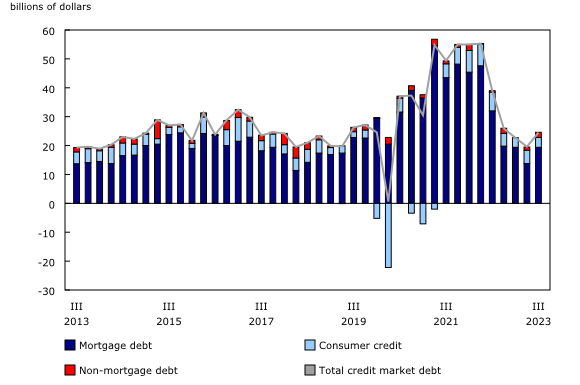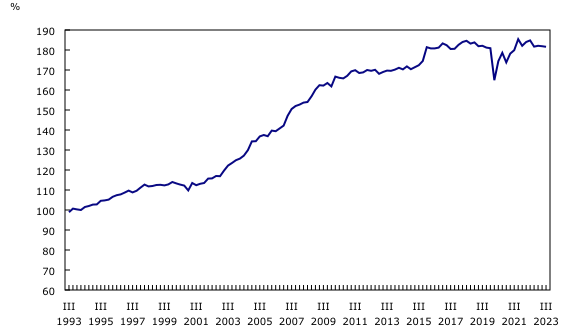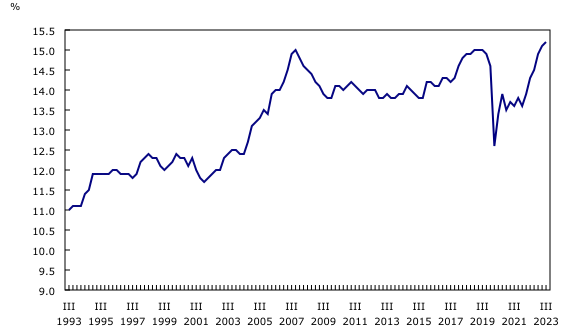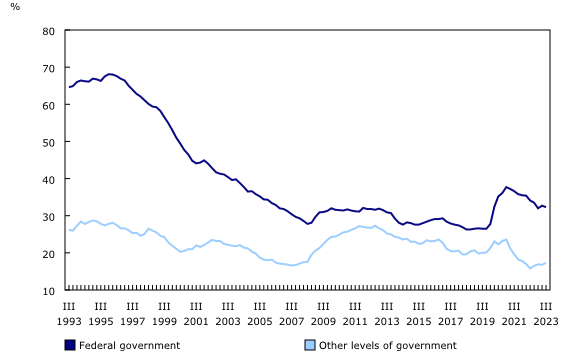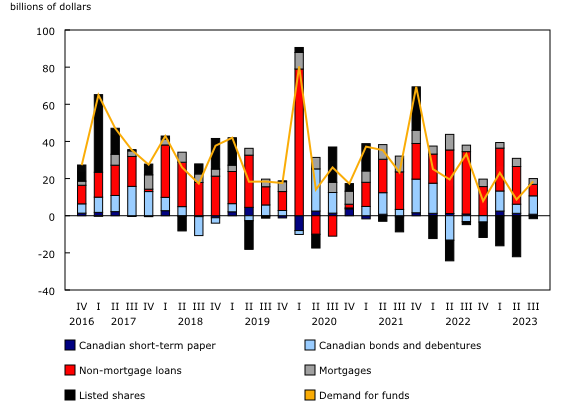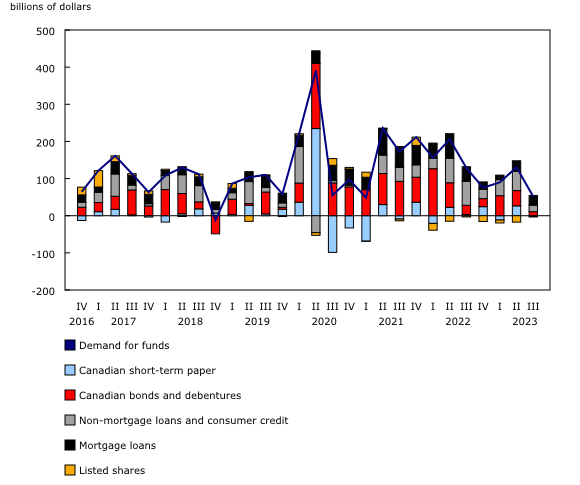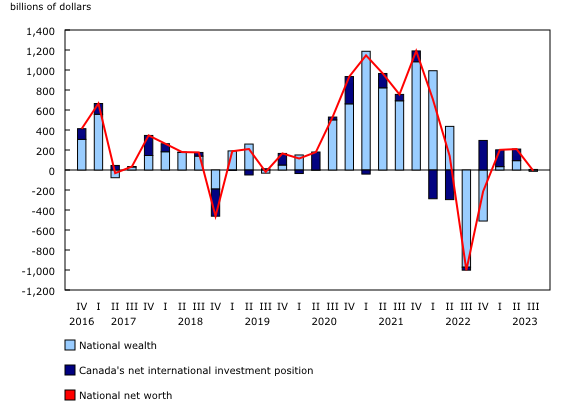National balance sheet and financial flow accounts, third quarter 2023
Released: 2023-12-13
Household net worth slumps as financial and housing markets weaken
Households were less wealthy in the third quarter as their net worth—the value of all assets minus all liabilities—shrank $301.2 billion (-1.8%) to $16,168.3 billion. Headwinds, in the form of weaker financial and housing markets, dragged on household wealth; the value of real estate declined after two quarters of recovery, while both foreign and domestic equity markets softened, with the Standard and Poor's (S&P) 500 Index falling 3.6% and the S&P/TSX Composite Index declining 3.0%. These market contractions pushed the value of households' total financial assets 2.1% lower (-$196.3 billion), while the value of total non-financial assets fell 0.8% (-$74.5 billion). On the other side of the ledger, financial liabilities, composed primarily of mortgage and non-mortgage debt, increased $30.5 billion from the second quarter. This represented the slowest year-over-year expansion (+3.2%) in household liabilities since 1990.
Despite higher saving rate, deposits slow and households divest from mutual funds
While the household saving rate rose to 5.1% on a seasonally adjusted basis in the third quarter, growth in household holdings of Canadian currency and deposits (unadjusted) continued to decelerate, posting the smallest quarterly increase (+0.7%) since the first quarter of 2021. At the same time, households recorded net redemptions in mutual funds of $2.7 billion in the third quarter despite the seventh consecutive quarter of continued inflows into money market funds, which benefit from higher interest rates. Outflows continued in mutual funds, while both money market funds and exchange-traded funds recorded inflows.
Highlights
The Canadian economy shrank during the third quarter, as an increase in the nominal gross domestic product was outpaced by inflation. On a real basis, this decline was led by slower inventory accumulation and a decrease in exports that were only partially offset by increases in government spending and housing construction. The business outlook deteriorated relative to the second quarter as worries around rising inflation and rising input costs continued.
The household saving rate increased slightly in the third quarter as household disposable income outpaced weakening household consumption. In July, the Bank of Canada increased the policy interest rate to 5% where it has remained following three further rate announcements. In the third quarter, household mortgage borrowing activity expanded after four consecutive quarters of decline, while the value of real estate declined after two quarters of increases.
The dual impact of weakening housing and financial markets led to lower household net worth. Federal government credit market borrowing decelerated as it continued to issue shorter term debt and retire longer term debt. Canada's net foreign asset position improved despite declining global financial markets due to a weakening Canadian dollar.
Residential real estate prices dip as housing investment rises
The value of household residential real estate declined 1.0% (-$85.1 billion) during the third quarter, reversing course from the first half of 2023 (+5.3%). The average resale price of residential homes sold fell 8.3% from the second quarter, representing a price drop of almost $60,000. However, compared with the third quarter of 2022, the number of home sales rose 5.1% in the third quarter of 2023, but was still 25.2% below the pace of sales from 2021. Despite the decline in resale prices, residential building construction prices rose in the third quarter of 2023. Meanwhile, on a seasonally adjusted real basis, housing investment rose for the first time in six quarters on the strength of a 6.5% increase in new construction.
Household borrowing picks up
During the third quarter, the pace of seasonally adjusted household credit market borrowing rose as households demanded $24.5 billion in funds, following four consecutive quarters of deceleration. The uptick in borrowing was largely due to a jump in demand for mortgage loans, which rose from $13.8 billion in the second quarter to $19.4 billion in the third quarter.
The seasonally adjusted stock of household credit market debt (consumer credit, and mortgage and non-mortgage loans) grew 0.8% from the second quarter to reach $2,889.4 billion in the third quarter, with mortgage debt ($2,147.2 billion) accounting for almost three-quarters of the total outstanding debt.
Household debt service costs continue to climb
On a seasonally adjusted basis, household credit market debt as a proportion of household disposable income fell to 181.6% in the third quarter from 181.9% in the second quarter, as household disposable income (+1.0%) grew slightly faster than credit market debt (+0.8%). In other words, there was $1.82 in credit market debt for every dollar of household disposable income in the third quarter.
The household debt service ratio, measured as total obligated payments of principal and interest on credit market debt as a proportion of household disposable income, rose to 15.22% in the third quarter, increasing from 15.08% in the second quarter as debt payments expanded at a faster rate than household disposable income. Growth in income and debt are not shared equally among all income brackets.
Since the Bank of Canada started raising interest rates in the first quarter of 2022, the amount of total mortgage interest payments has increased 89.6%. During that same period, the amount of mortgage principal paid has declined by 16.8%. The third quarter of 2023 marked a deceleration in mortgage interest payments (+3.6%) compared with the previous quarter (+5.9%), while mortgage principal payments increased slightly (+0.2%) after five consecutive declines.
Financial wellness and the national balance sheet and financial flow accounts
As you may know, November was Financial Literacy Month. Although this national balance sheet accounts release is a few weeks after the fact, we know the importance of understanding personal household finances, managing debt, and knowing how to react when facing financial pressures. We also appreciate the terminology that goes along with many financial concepts—terms that you may find in The Daily.
The national balance sheet and financial flow accounts are key tools in assessing household sector financial health. In these times, looking after your personal financial wellness is also paramount. Canadians can visit the Money and finances page on Canada.ca for practical tips and tools on managing money and debt in today's economic environment.
Federal government credit market borrowing slows while the ratio of net financial liabilities to gross domestic product improves
In the third quarter, the federal government borrowed $9.5 billion in bonds and treasury bills, a notable shift from the $28.2 billion recorded in the second quarter. The third quarter borrowings primarily consisted of net issuances in treasury bills (+$24.6 billion), which were partially offset by net redemptions of bonds (-$14.6 billion). Overall, the federal government continued to borrow through short term instruments for the fifth consecutive quarter. With treasury bill yields at levels last seen in 2001, the effective interest cost on federal government debt continued to grow in the third quarter, with maturing debt becoming more costly to replace with new borrowing at higher rates.
The Bank of Canada continued its quantitative tightening program in the third quarter, with the central bank allowing a record $33.0 billion worth of federal government bonds to mature without replacement in order to shrink the size of its balance sheet. Similarly, non-residents reduced their exposure to federal government bonds (-$13.6 billion), the largest quarterly divestment since the first quarter of 2018. Meanwhile, chartered banks, mutual funds, and pension funds provided liquidity to the federal bond market, purchasing $22.6 billion in bonds in the third quarter of 2023.
The ratio of federal government net financial liabilities to gross domestic product decreased from 32.7% in the second quarter to 32.3% in the third quarter as net financial liabilities edged down. Aside from the second quarter of 2023, the ratio has declined in every quarter since the first quarter of 2021.
Private non-financial corporations' demand for funds on the rise
The demand for funds by private non-financial corporations increased to $18.5 billion in the third quarter from $8.7 billion in the second quarter. The increase was concentrated in bonds, which rose $9.9 billion from the previous quarter. Listed shares recorded net redemptions in the third quarter (-$1.6 billion), but this latest result paled in comparison to the second quarter (-$22.1 billion) in which significant merger and acquisition activity occurred. However, since the end of 2021, there have been seven consecutive quarters of net redemptions totalling $73.3 billion. Meanwhile, non-mortgage loans rose at a more muted pace (+$6.2 billion) compared with the second quarter (+$20.3 billion).
Domestic demand for funds falls
The demand for funds in Canada was $96.6 billion in the third quarter, a drop from $183.9 billion in the previous quarter. A similar drop can also be observed in the chartered banking sector's supply of funds, which injected $71.8 billion of funds into financial and credit markets in the third quarter, compared with $98.4 billion in the second quarter.
National net worth moderates as house prices slip
National net worth, the sum of national wealth and Canada's net foreign asset position, remained nearly unchanged, at $18,352.6 billion (-$7.7 billion) in the third quarter. This followed two consecutive quarterly increases to start 2023, fuelled by relatively strong real estate activity.
The total value of non-financial assets in Canada, also referred to as national wealth, edged down 0.1% in the third quarter to $16,970.2 billion. The combined value of natural resources (including land) dropped by $118.1 billion, but this was mostly offset by growth in the value of Canada's produced assets, particularly among residential and non-residential structures and inventories.
Canada's net foreign asset position, the difference between Canada's international financial assets and international liabilities, edged up by $5.5 billion to reach $1,382.4 billion in the third quarter, following three quarters of substantial increases. Overall, the upward revaluations from fluctuations in exchange rates was offset by the downward revaluations due to market price changes, with equity and fixed income markets slowing in both Canada and the United States.
Note to readers
Revisions
Data enhancements to the national balance sheet and financial flow accounts, such as the development of detailed counterparty information by sector, will be incorporated on an ongoing basis. To facilitate this initiative as well as others, it is necessary to extend the annual revision period (normally the previous three years) at the time of the third quarter release. Consequently, with this release of the national balance sheet and financial flow accounts for the third quarter of 2023, data was revised back to 1990 to incorporate improvements and ensure a continuous time series. These data incorporate new and revised data, as well as updated data on seasonal trends.
Details on these revisions are available in "An overview of revisions to the Financial and Wealth Accounts, 1990 to 2023."
General
Unless otherwise stated, growth rates represent the percentage change in the series from one quarter to the next; for instance, from the second quarter of 2023 to the third quarter of 2023.
Unless otherwise stated, this release presents data unadjusted for seasonality.
Support measures by governments
Details on some of the more significant federal government COVID-19 support measures are now available in table 36-10-0687: Federal government COVID-19 response measures in the System of Macroeconomic Accounts, quarterly.
Financial and wealth accounts on a from-whom-to-whom basis: Selected financial instruments
The data visualization product "Financial accounts on a from-whom-to-whom basis, selected financial instruments" has been updated with data from the first quarter of 1990 to the third quarter of 2023.
Next release
Data on the national balance sheet and financial flow accounts for the fourth quarter of 2023 will be released on March 13, 2024.
Overview of the financial and wealth accounts
This release of the financial and wealth accounts comprises the national balance sheet accounts (NBSA), the financial flow accounts (FFA), and the other changes in assets account.
The NBSA are composed of the balance sheets of all sectors and subsectors of the economy. The main sectors are households, non-profit institutions serving households, financial corporations, non-financial corporations, government, and non-residents. The NBSA cover all national non-financial assets and all financial asset-liability claims outstanding in all sectors. To improve the interpretability of financial flows data, selected household borrowing series are available on a seasonally adjusted basis (table 38-10-0238-01). All other data are unadjusted for seasonal variation. For information on seasonal adjustment, see Seasonally adjusted data – Frequently asked questions.
The FFA articulate net lending or borrowing activity by sector by measuring financial transactions in the economy. The FFA arrive at a measure of net financial investment, which is the difference between transactions in financial assets and liabilities (for example, net purchases of securities less net issuances of securities). The FFA also provide the link between financial and non-financial activity in the economy, which ties estimates of saving and non-financial capital acquisition (for example, investment in new housing) to the underlying financial transactions.
While the FFA record changes in financial assets and liabilities between opening and closing balance sheets that are associated with transactions during the accounting period, the value of assets and liabilities held by an institution can also change for other reasons. These other types of changes, referred to as other economic flows, are recorded in the other changes in assets account.
There are two main components to this account. One is the other changes in the volume of assets account. This account includes changes in non-financial and financial assets and liabilities relating to the economic appearance and disappearance of assets, the effects of external events such as wars or catastrophes on the value of assets, and changes in the classification and structure of assets. The other main component is the revaluation account, showing holding gains or losses accruing to the owners of non-financial and financial assets and liabilities during the accounting period as a result of changes in market price valuations.
At present, only the aggregate other change in assets is available within the Canadian System of Macroeconomic Accounts; no details are available on the different components.
Definitions concerning financial indicators can be found in "Financial indicators from the National Balance Sheet Accounts" and in the Canadian System of Macroeconomic Accounts glossary.
Distributions of household economic accounts
The NBSA for the household sector is allocated across a number of socioeconomic dimensions as part of the distributions of household economic accounts. Data on wealth and its components by income quintile, age group, generation and region are available in tables 36-10-0660-01, 36-10-0661-01, 36-10-0664-01, and 36-10-0665-01.
The methodology for Distributions of household economic accounts wealth estimates can be found in the article "Distributions of Household Economic Accounts, estimates of asset, liability and net worth distributions, 2010 to 2019, technical methodology and quality report."
Products
The document, " An overview of revisions to the Financial and Wealth Accounts, 1990 to 2023," which is part of Latest Developments in the Canadian Economic Accounts (13-605-X), is now available.
The data visualization product "Financial accounts on a from-whom-to-whom basis, selected financial instruments," which is part of Statistics Canada – Data Visualization Products (71-607-X), is now available.
The data visualization product "Overview of the stock and consumption of fixed capital program: Interactive tool," which is part of Statistics Canada – Data Visualization Products (71-607-X), is now available.
As a complement to this release, you can also consult the data visualization product "Distributions of Household Economic Accounts, Wealth: Interactive tool," which is part of Statistics Canada – Data Visualization Products (71-607-X).
As a complement to this release, you can also consult the data visualization product "Securities statistics," which is part of Statistics Canada – Data Visualization Products (71-607-X).
The Economic accounts statistics portal, accessible from the Subjects module of our website, features an up-to-date portrait of national and provincial economies and their structure.
The User Guide: Canadian System of Macroeconomic Accounts (13-606-G) is available.
The Methodological Guide: Canadian System of Macroeconomic Accounts (13-607-X) is available.
The Canada: Economic and Financial Data - International Monetary Fund's Special Data Dissemination Standard Plus product (13-608-X), "Other Financial Corporations Survey," also known as "Assets and liabilities of other financial corporations by sector, market value, quarterly" (36-10-0668-01), are available.
Contact information
For more information, or to enquire about the concepts, methods or data quality of this release, contact us (toll-free 1-800-263-1136; 514-283-8300; infostats@statcan.gc.ca) or Media Relations (statcan.mediahotline-ligneinfomedias.statcan@statcan.gc.ca).
- Date modified:



